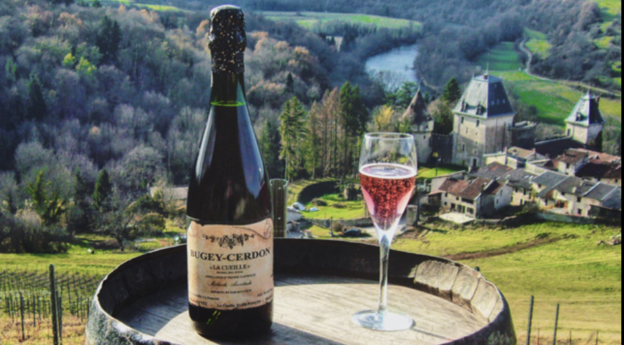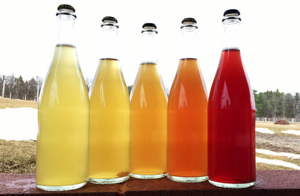Bugey is a wine I love to include in my in-person tasting events, as either a starter or a finisher. It fills both spots nicely – bubbles to celebrate the start of an event, or something semi-sweet to pair with dessert. There aren’t too many wines out there that can fill both positions with the prettiness and finesse of Bugey-Cerdon. It has been hailed as “the happiest wine on earth.”
Bugey is a tiny (1,000 acres of vineyards), little known Alpine hamlet in eastern France, halfway between Lyon and Geneva. It is located in the “middle of nowhere” foothills of the Jura Mountains, bordered by Beaujolais to the west, Savoie to the east, Jura and Burgundy to the north, and the Rhone to the south. The vineyards are not contiguous – they are scattered throughout this small region nestled in valleys between mountains and ridges.
Here you will find a cool, sub-Alpine climate of cold winters and mild summers where grapes can struggle to ripen. This is a climate well suited to sparkling wines, which only need “just ripe enough” grapes to get good flavor, but preserve that all-important acidity.
The Bugey region produces a number of different grape varieties, mostly white, aromatic, lower in alcohol, and higher in acidity. Chardonnay is it’s primary varietal, but they also grow Jacquère, Altesse and Aligoté for the whites, and Poulsard, Mondeuse, Pinot Noir and Gamay for the reds.
However, its most famous and distinctive wine is Bugey-Cerdon. Wine from Cerdon, one of Bugey’s three cru areas, is always sparkling, fetchingly pink, and a touch sweet with low alcohol (around 8% ABV). These incredibly easy drinking wines are made from a blend of Gamay and Poulsard grapes, and the flavors are reminiscent of wild berries, strawberries and cream.
According to French law, Bugey-Cerdon must be made by the méthode ancestrale (also known as pet-nat, petillent natural, ancestral method, or col fondo), an ancient process for producing bubbly wine that predates Champagne.
In méthode ancestrale, partially fermented wine is bottled with its remaining residual sugar and yeast. Fermentation then continues in the bottle and the byproduct of carbon dioxide becomes trapped, creating bubbles. This technique was likely discovered by accident. During the winter months, yeast becomes dormant when the wine is bottled, then the yeast awakens with warm spring temperatures and finishes fermenting. Many small producers use this process because it’s the most accessible way to make sparkling wine as it doesn’t require the expensive equipment needed to make Champagne method wines.
Bugey-Cerdon must be aged in the bottle on lees (dead yeast cells) for a minimum of 9 months, imparting a creamy texture. Many of these wines may be left unfined and unfiltered, so may include some leftover yeast cells, resulting in a slightly hazy appearance.
These wines have lower pressures, calmer foam and larger bubbles than Champagne-method wines. This means they are more aromatic and flavorful upon opening, but the bubbles will dissipate more quickly as the wine ages so they are meant to be drunk young and not cellared.
Recommendations:
- Patrick Bottex Bugey Cerdon La Cueille ($20)
- Daniel Boccard Cerdon Bugey Demi-Sec Rose ($23)

